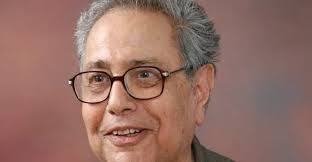By Satyapal Anand
“A pair of Ragged Claws…..”
That was Elliot almost a century ago. Now it is another new entrant to English from the hoary horizons of Urdu (a dialect of Arabic Indian) who has vied with Elliot to come up with more than a mere pair of ragged claws.
A wave, a buzz, and then a low noise it has been. Someone said it is a new entrant in the realm of American poetry who has thrown five books before literary wolves for them to tear into shards. When I picked up The Dream Weaver, the first of these five, I found that the new entrant was not a novice but an 80-years old man with a lifetime of creative activity behind him. What is so very special about these poems that there has been a buzz in the tribe of reviewers and bloggers? I believe it is because Satyapal Anand’s poems are a different breed, not a graft on the gnarled
tree of American poetry. They are unspoiled, firm, and savory like fresh fruit. Unlike faded oldies tiredly repeating themselves in worn verbosity or fresh starts with their snippy and sassy verbal outpouring, this poet has a method, a sure design to present a finished product, a poem knit together in an organic unity, His method is simple; he takes a fable, a character or a happening from mythology (Greek, Roman,
Hindu, Muslim – it doesn’t matter), places its blow-print in today’s context and then stands aside to see the interplay. The result is not only satisfying; it is etched in the memory of the reader.
In the present volume in as many as 32 poems, this time-honored method is used, a method once made popular by Elliot and others. To catalogue at random, Christ, Diogenes, Nietzsche, Buddha, Shakespeare, Cyclopes, Mona Liza, Renoir, and many others constitute the dramatis personae, while Mithun, Yang-Yen, Bi-polar characters in the cosmology of gods, Indian epics like Ramayana and Mahabharata, Dante’s Divine Comedy, Hindu sacred mantras – these are used as strong photo frames for what occurs in the poems. Subjects or topics are the staple part of poems. The poet does falter here and there in his choices and brings themes beyond the reach of an ordinary American reader, but, by and large, he succeeds in presenting something novel and strange, not altogether unheard of but at least faraway in time and place.
Movies have painted horrible scenes of what it might look like after total annihilation, man-made or God-ordained.
Here is the poem “All by Himself, Alone”.
One who sits on the balcony
And looks down in the street
Sometimes shading his eyes
Looking up and
down in the distance
Hoping for a wayfarer to come
Stop below and look up to him.
One who sits on the balcony
Waiting for just such a moment
For him to rush down and hug him
Escort him inside the house
Serve him tea
Talk to him.
The one who sits on the balcony
Doesn’t know that mankind has committed suicide
Mankind is dead
He is the only one left alive
All alone, all by himself
The last specimen of a race of human beings
…The one who sits on the balcony.
I need not comment on this poem. It is simple as simple can be. It is slow-paced but sharp as sharp can be. The reader can easily put himself in place of the last specimen of mankind sitting on his balcony.
There are poems, of course, complex and need a key to open their mystery but once the key is found, they become simple narratives. One such poem is “Diogenes for a day”. Cynicism, we know, is a bent of mind: it is not misanthropy but a jaundiced way of looking at things, good and bad alike. Here are a couple of excerpts from this poem.
I am but a cynic
If I smell flowers, I avert my gaze from
A blooming female fact
Look around for a
coffin laden with flowers
See people walking in the street
With their heads like upturned frying
pans. …
The night for me comes like a stricken ghoul
On my legs is my body, a trunk
My head is hidden inside my arms like a tortoises
I sleep like a fetus unborn.
In the famed Ajanta caves in India are hundreds of icons. Some do present Yoga calibrations. Intertwined male-female stone cut figurines present mithun in Indian yoga posture or yang-Yen, the male-female conjoined posture. I may have to quote the poem in full for the reader to feel its impact.
Carved statues these are
Deep down in the Ajanta Coves
They stand alone in their eternal wakefulness
Maybe, they have dreams like ours
Maybe, they are awake inside their stone selves.
Walking in the narrow passage
My feet are just arrested – I don’t know why
It is as if they have a will of their own.
It is a sculpture A graceful two as it were.
Tightly embraced in a physical blend
Two human bodies unified as one.
A male and a female
Yes, but only if they are parted
Together they are male physiognomy
Their geometry of togetherness
They are but one.
Is it ‘mithun’?
Or ‘Yang and Yin’?
My intellectual self seems to be flabbergasted.
The poet, however, has his punch line in reserve. He hits it hard, popping up and puncturing your skin. Here it is.
The sculpted duo
suddenly open their stone cast eye
Look at me with a piercing stare
As if complaining of intrusion.
I walk fast to get out of the chamber
Dare I disturb their eternal sleep, I ask myself
But dare not look back
For I am ashamed of myself.
These poems, I dare say, are different from ‘poetry’ as we know it here. For one, they are like freshly garnered flowers imported from the East. For another,
A poem should just ‘be’. No meaning or less meaning is always welcome, but let me assure you of my own experience. Once a poem was finished by me, I had to pause and some kind of a ‘meaning’ struggled to register itself in my mind.




